Why Do Users Switch from Ride-Hailing to Robotaxi? Exploring Sustainable Mobility Decisions Through a Push–Pull–Mooring Perspective
Abstract
1. Introduction
2. Literature Review
2.1. From Ride-Hailing to Robotaxi: User Research
2.2. Push–Pull–Mooring (PPM)
3. Model Conceptualization and Hypotheses Development
3.1. Push Hypotheses
3.1.1. Social Anxiety (SAN) and Switching Intention (SWI)
3.1.2. Human-Induced Insecurity (HII) and Switching Intention (SWI)
3.2. Pull Hypotheses
3.2.1. Perceived Autonomy (PAU) and Switching Intention (SWI)
3.2.2. Perceived Service Reliability (PSR) and Switching Intention (SWI)
3.3. Mooring Hypotheses
3.3.1. Habit (HAB) and Switching Intention (SWI)
3.3.2. Perceived Robotaxi Risk (PRR) and Switching Intention (SWI)
3.4. Moderating Hypotheses
3.4.1. The Moderating Role of Habit (HAB)
3.4.2. The Moderating Role of Perceived Robotaxi Risk (PRR)
4. Method
4.1. Measurement
4.2. Sample and Data Collection
4.3. Common Method Bias
5. Results
5.1. Measurement Model
5.2. Model Fit, Explanatory Power, and Predictive Power
5.3. Direct Effect Test
5.4. Moderating Effect
5.5. Multi-Group Analysis
6. Discussion
6.1. Theoretical Contributions
6.2. Practical Implications
6.3. Limitations and Future Research
7. Conclusions
Author Contributions
Funding
Institutional Review Board Statement
Informed Consent Statement
Data Availability Statement
Acknowledgments
Conflicts of Interest
Abbreviations
| PPM | Push–Pull–Mooring framework |
| PLS-SEM | Partial Least Squares Structural Equation Modeling |
| MGA | Multi-Group Analysis |
| MICOM | Measurement Invariance of Composite Models |
| SRMR | Standardized Root Mean Square Residual |
| NFI | Normed Fit Index |
| AVE | Average Variance Extracted |
| CR | Composite Reliability |
| HTMT | Heterotrait–Monotrait ratio |
| VIF | Variance Inflation Factor |
| CMB | Common Method Bias |
Appendix A
| Construct | Item | Scale |
| Social Anxiety (SAN) | 1. When using ride-hailing, I often feel nervous or uneasy if there is a driver in the car. | 7-point Likert scale (1 = strongly disagree, 7 = strongly agree) |
| 2. I worry about saying the wrong thing or leaving a bad impression when communicating with the driver. | ||
| 3. I try to avoid unnecessary interactions with ride-hailing drivers. | ||
| 4. I sometimes feel uncomfortable when a driver is present in the car. | ||
| Human-Induced Insecurity (HII) | 1. I am concerned that ride-hailing drivers may become distracted or inattentive while driving. | 7-point Likert scale (1 = strongly disagree, 7 = strongly agree) |
| 2. If a driver shows emotional agitation or aggressive behavior (e.g., arguing, road rage), I feel unsafe. | ||
| 3. An unpleasant in-car environment caused by the driver (e.g., smoking, odors) makes me feel uncomfortable. | ||
| 4. The unpredictability of driver behavior makes me worry about my safety in ride-hailing. | ||
| Perceived Autonomy (PAU) | 1. Robotaxi give me a stronger sense of personal freedom. | 7-point Likert scale (1 = strongly disagree, 7 = strongly agree) |
| 2. In Robotaxi, I feel I can fully control my travel experience without social pressure from a driver. | ||
| 3. Robotaxi provide a more private space, allowing me to act more freely during travel. | ||
| 4. Using Robotaxi makes me feel greater autonomy and self-determination in travel decisions. | ||
| Perceived Service Reliability (PSR) | 1. Robotaxi services can reliably complete the intended travel tasks. | 7-point Likert scale (1 = strongly disagree, 7 = strongly agree) |
| 2. Robotaxi accurately follow the system-planned routes. | ||
| 3. Robotaxi can operate reliably under different traffic and weather conditions. | ||
| 4. I believe Robotaxi can transport me to my destination safely and consistently. | ||
| Habit (HAB) | 1. Using ride-hailing has become a habit for me. | 7-point Likert scale (1 = strongly disagree, 7 = strongly agree) |
| 2. When I need to travel, I instinctively choose ride-hailing. | ||
| 3. Using ride-hailing is something I do without deliberate thought. | ||
| 4. I feel uncomfortable or uneasy if I do not use ride-hailing for travel. | ||
| Perceived Robotaxi Risk (PRR) | 1. I worry that Robotaxi may be unstable and could malfunction during a trip. | 7-point Likert scale (1 = strongly disagree, 7 = strongly agree) |
| 2.I am concerned that using Robotaxi may involve safety risks (e.g., traffic accidents or emergencies). | ||
| 3. I am concerned that Robotaxi may disclose my personal information or travel data. | ||
| 4 I worry that system or technical failures in Robotaxi may compromise travel safety. | ||
| Switching Intention (SWI) | 1. I intend to switch from ride-hailing to Robotaxi in my future travel. | 7-point Likert scale (1 = strongly disagree, 7 = strongly agree) |
| 2. I will increasingly choose Robotaxi rather than ride-hailing in the future. | ||
| 3. It is highly likely that I will replace ride-hailing with Robotaxi as my main mode of travel. |
References
- Bala, H.; Anowar, S.; Chng, S.; Cheah, L. Review of Studies on Public Acceptability and Acceptance of Shared Autonomous Mobility Services: Past, Present and Future. Transp. Rev. 2023, 43, 970–996. [Google Scholar] [CrossRef]
- Narayanan, S.; Chaniotakis, E.; Antoniou, C. Shared Autonomous Vehicle Services: A Comprehensive Review. Transp. Res. Part C Emerg. Technol. 2020, 111, 255–293. [Google Scholar] [CrossRef]
- Johannes, D. The Future of Autonomous Vehicles (AV)|McKinsey. Available online: https://www.mckinsey.com/industries/automotive-and-assembly/our-insights/autonomous-drivings-future-convenient-and-connected (accessed on 6 June 2025).
- Mehra, A. Robotaxi Market Worth $45.7 Billion by 2030. Available online: https://www.marketsandmarkets.com/PressReleases/robo-taxi.asp (accessed on 6 September 2025).
- Apollo Apollo Go Robotaxi: Autonomous Ride-Hailing Service Provider. Available online: https://www.apollogo.com/ (accessed on 13 June 2025).
- Bellet, T.; Banet, A. UTAUT4-AV: An Extension of the UTAUT Model to Study Intention to Use Automated Shuttles and the Societal Acceptance of Different Types of Automated Vehicles. Transp. Res. Part F Traffic Psychol. Behav. 2023, 99, 239–261. [Google Scholar] [CrossRef]
- La Delfa, A.; Han, Z. Sustainable Mobility and Shared Autonomous Vehicles: A Systematic Literature Review of Travel Behavior Impacts. Sustainability 2025, 17, 3092. [Google Scholar] [CrossRef]
- Mu, J.; Zhou, L.; Yang, C. Research on the Behavior Influence Mechanism of Users’ Continuous Usage of Autonomous Driving Systems Based on the Extended Technology Acceptance Model and External Factors. Sustainability 2024, 16, 9696. [Google Scholar] [CrossRef]
- Jia, S.; Chi, O.H.; Jo, E.H.; Yu, M. Ethical Concerns of Aging and Gender in Autonomous Taxis. Ann. Tour. Res. 2025, 111, 103930. [Google Scholar] [CrossRef]
- Liu, Y.X.; Li, H.; Pan, Y. Why Do Users Trust Robotaxi? Analyzing User Differences and Adoption Behavior from a Socio-Technical Perspective. J. Retail. Consum. Serv. 2025, 87, 104393. [Google Scholar] [CrossRef]
- Xie, H.; David, A.; Mamun, M.R.A.; Prybutok, V.R.; Sidorova, A. The Formation of Initial Trust by Potential Passengers of Self-Driving Taxis. J. Decis. Syst. 2023, 32, 326–355. [Google Scholar] [CrossRef]
- Vega-Gonzalo, M.; Aguilera-García, Á.; Gomez, J.; Vassallo, J.M. Traditional Taxi, e-Hailing or Ride-Hailing? A GSEM Approach to Exploring Service Adoption Patterns. Transportation 2024, 51, 1239–1278. [Google Scholar] [CrossRef]
- Abbasi, M.; Mamdoohi, A.R.; Ciari, F.; Sierpiński, G. An Investigation of Perceived Risk Dimensions in Acceptability of Shared Autonomous Vehicles, a Mediation-Moderation Analysis. Sci. Rep. 2024, 14, 23276. [Google Scholar] [CrossRef]
- Jaydarifard, S.; Yigitcanlar, T.; Paz, A. Risk Factors and Safety Strategies for Mitigating Violations, Harassment and Assault in Taxi and Ride-Hailing Services. Transp. Rev. 2025, 45, 776–800. [Google Scholar] [CrossRef]
- Alqahtani, H.; Kumar, G. Cybersecurity in Electric and Flying Vehicles: Threats, Challenges, AI Solutions & Future Directions. ACM Comput. Surv. 2025, 57, 1–34. [Google Scholar] [CrossRef]
- Lee, J.; Lee, D.; Park, Y.; Lee, S.; Ha, T. Autonomous Vehicles Can Be Shared, but a Feeling of Ownership Is Important: Examination of the Influential Factors for Intention to Use Autonomous Vehicles. Transp. Res. Part C Emerg. Technol. 2019, 107, 411–422. [Google Scholar] [CrossRef]
- Hoff, K.A.; Bashir, M. Trust in Automation: Integrating Empirical Evidence on Factors That Influence Trust. Hum Factors 2015, 57, 407–434. [Google Scholar] [CrossRef] [PubMed]
- Molinillo, S.; Caballero-Galeote, L.; Liébana-Cabanillas, F.; Ruiz-Montañez, M. Understanding Users’ Willingness to Travel on Autonomous Buses: The Moderating Effect of Experience. J. Retail. Consum. Serv. 2024, 81, 103931. [Google Scholar] [CrossRef]
- Qiao, S.; Schwanen, T.; Li, X.; Yeh, A.G.-O. Compounded Barriers: The Intersection of Gender and Age in Ride-Hailing Usage. Transportation 2025. [Google Scholar] [CrossRef]
- Zhu, Y.; Janssen, M.; Pu, C. Are Men from Mars, Women from Venus? Investigating the Determinants behind the Intention to Use Fully Automated Taxis. Transp. Lett. 2024, 16, 1366–1377. [Google Scholar] [CrossRef]
- Hu, S.; Yang, Y. Safety of Female Ride-Hailing Passengers: Perception and Prevention. Humanit. Soc. Sci. Commun. 2024, 11, 265. [Google Scholar] [CrossRef]
- Siddiq, F.; Taylor, B.D. A Gendered Perspective on Ride-Hail Use in Los Angeles, USA. Transp. Res. Interdiscip. Perspect. 2024, 23, 100938. [Google Scholar] [CrossRef]
- Fink, P.D.S.; Brown, J.R.; Kutzer, K.M.; Giudice, N.A. Does Trust Even Matter? Behavioral Evidence for the Disconnect between People’s Subjective Trust and Decisions to Use Autonomous Vehicles. Transp. Res. Part F Traffic Psychol. Behav. 2025, 114, 99–117. [Google Scholar] [CrossRef]
- Venkatesh, V.; Thong, J.Y.; Xu, X. Consumer Acceptance and Use of Information Technology: Extending the Unified Theory of Acceptance and Use of Technology. MIS Q. 2012, 36, 157. [Google Scholar] [CrossRef]
- Bansal, H.S. “Migrating” to New Service Providers: Toward a Unifying Framework of Consumers’ Switching Behaviors. J. Acad. Mark. Sci. 2005, 33, 96–115. [Google Scholar] [CrossRef]
- Li, J.; Zhang, A.; Wang, C.; Wang, S.; Liang, L. Switching Behavior in the Adoption of Electric Vehicle in China: Perspective of Push–Pull-Mooring Framework. Transp. Res. Part A Policy Pract. 2025, 192, 104359. [Google Scholar] [CrossRef]
- Olayode, I.O.; Severino, A.; Justice Alex, F.; Macioszek, E.; Tartibu, L.K. Systematic Review on the Evaluation of the Effects of Ride-Hailing Services on Public Road Transportation. Transp. Res. Interdiscip. Perspect. 2023, 22, 100943. [Google Scholar] [CrossRef]
- Yin, J.; Zhao, F.; Tang, W.; Ma, J. The Nonlinear and Threshold Effect of Built Environment on Ride-Hailing Travel Demand. Appl. Sci. 2024, 14, 4072. [Google Scholar] [CrossRef]
- Li, X.; Du, M.; Zhang, Y.; Yang, J. Identifying the Factors Influencing the Choice of Different Ride-Hailing Services in Shenzhen, China. Travel Behav. Soc. 2022, 29, 53–64. [Google Scholar] [CrossRef]
- Jiang, G.; Yang, W.; Zhang, N. Effect of Perceived Risks, Perceived Benefits and Regulatory Events on Users’ Supervision Intention towards e-Hailing Platforms: A Mixed Method. J. Inf. Sci. 2025, 51, 50–72. [Google Scholar] [CrossRef]
- Agrawal, S.; Schuster, A.M.; Britt, N.; Mack, E.A.; Tidwell, M.L.; Cotten, S.R. Building on the Past to Help Prepare the Workforce for the Future with Automated Vehicles: A Systematic Review of Automated Passenger Vehicle Deployment Timelines. Technol. Soc. 2023, 72, 102186. [Google Scholar] [CrossRef]
- Yao, X.; Liu, J.; Wang, X.; Xiao, Y.; Qi, G. Transition toward Driverless Robotaxi: Role of Social Anxiety, Perceived Safety, and Travel Habit. Transp. Res. Part F Traffic Psychol. Behav. 2025, 109, 1402–1418. [Google Scholar] [CrossRef]
- Greifenstein, M. Factors Influencing the User Behaviour of Shared Autonomous Vehicles (SAVs): A Systematic Literature Review. Transp. Res. Part F Traffic Psychol. Behav. 2024, 100, 323–345. [Google Scholar] [CrossRef]
- Wei, W.; Sun, J.; Miao, W.; Chen, T.; Sun, H.; Lin, S.; Gu, C. Using the Extended Unified Theory of Acceptance and Use of Technology to Explore How to Increase Users’ Intention to Take a Robotaxi. Humanit. Soc. Sci. Commun. 2024, 11, 746. [Google Scholar] [CrossRef]
- Lin, B.; Fan, Y.; Yang, R. The Future of Urban Travel and Tourism: A Text Mining Analysis of Robotaxi Sentiment and Adoption. J. Travel Tour. Mark. 2025, 42, 479–494. [Google Scholar] [CrossRef]
- Al Mansoori, S.; Al-Emran, M.; Shaalan, K. Factors Affecting Autonomous Vehicles Adoption: A Systematic Review, Proposed Framework, and Future Roadmap. Int. J. Hum.–Comput. Interact. 2024, 40, 8397–8418. [Google Scholar] [CrossRef]
- Du, K.; Ryu, M.H. Use of Robotaxi Services for Sustainable Transportation: Focusing on Their Perceived Benefits and Sacrifices as Well as Consumers’ Technology Readiness. Sustainability 2025, 17, 8020. [Google Scholar] [CrossRef]
- Lee, E.S. A Theory of Migration. Demography 1966, 3, 47–57. [Google Scholar] [CrossRef]
- Kushwah, S.; Iyer, R.; Agrawal, A.; Korpal, S. Understanding Switching Intentions towards Renewable Energy Technologies Using Push-Pull-Mooring Framework. J. Clean. Prod. 2024, 465, 142656. [Google Scholar] [CrossRef]
- Chen, L.; Wu, P.; Dou, Y.; Wu, Y. Investigating Senders’ Switching Intention to Smart Lockers: An Extension of Push-Pull-Mooring Model. J. Retail. Consum. Serv. 2023, 74, 103414. [Google Scholar] [CrossRef]
- Jiang, L.; Ren, Y.; Xie, Y.; Ma, Y. Optimizing Delivery: A Push-Pull-Mooring Framework Analysis of Chinese Customers’ Shift from Home Delivery to Parcel Lockers. Ind. Manag. Data Syst. 2025, 1–26. [Google Scholar] [CrossRef]
- Zhang, Y.; Oh, H.-K.; Lee, C.H. Understanding Consumer Switching Intention of Peer-to-Peer Accommodation: A Push-Pull-Mooring Framework. J. Hosp. Tour. Manag. 2021, 49, 321–330. [Google Scholar] [CrossRef]
- Lian, J.-W.; Li, C.-W. Using a Two-Stage Method to Understand the Critical Factors Influencing Customers’ Intention to Switch from Traditional to Artificial Intelligence Based Banking Services: A Perspective Based on the Push–Pull–Mooring Model. Comput. Hum. Behav. 2025, 168, 108645. [Google Scholar] [CrossRef]
- Liu, Y.; Liang, Z.; Li, C.; Guo, J.; Zhao, G. An Investigation into the Adoption Behavior of mHealth Users: From the Perspective of the Push-Pull-Mooring Framework. Sustainability 2022, 14, 14372. [Google Scholar] [CrossRef]
- Motwani, K.; Choubey, S.; Saxena, A.; Mehta, M.; Patni, I. Decoding Mobile Payment Application Switching: Insights from the Push-Pull-Mooring Framework. China Financ. Rev. Int. 2025, 1–21. [Google Scholar] [CrossRef]
- Tsai, P.-H.; Tang, J.-W. Consumers’ Switching Intention towards E-Commerce Platforms’ Store-to-Store Pickup Services: The Application of the Extended PPM Model. J. Retail. Consum. Serv. 2023, 75, 103535. [Google Scholar] [CrossRef]
- Hu, X.; Wang, S.; Zhou, R.; Gao, L.; Zhu, Z. Determinants of Consumers’ Intentions to Switch to Electric Vehicles: A Perspective of the Push–Pull–Mooring Framework. J. Environ. Plan. Manag. 2024, 67, 3718–3743. [Google Scholar] [CrossRef]
- Yu, T.; Teoh, A.P.; Liao, J.; Wang, C. Determinants of Switching Intention to Adopt Electric Vehicles: A Comparative Analysis of China and Malaysia. Technol. Soc. 2025, 82, 102949. [Google Scholar] [CrossRef]
- Zhang, J.; Rasiah, R. Factors Influencing Customers’ Switching Intentions to New Energy Vehicles Based on the Push-Pull Mooring Model Using SEM-ANN Approach in Shanxi, China. Sci. Rep. 2025, 15, 27140. [Google Scholar] [CrossRef]
- Narayanan, S.; Antoniou, C. Shared Mobility Services towards Mobility as a Service (MaaS): What, Who and When? Transp. Res. Part A Policy Pract. 2023, 168, 103581. [Google Scholar] [CrossRef]
- Das, S.; Datta, B. Application of UTAUT2 on Adopting Artificial Intelligence Powered Lead Management System (AI-LMS) in Passenger Car Sales. Technol. Forecast. Soc. Chang. 2024, 201, 123241. [Google Scholar] [CrossRef]
- Laeeque, S.H.; Ali, M. When Passengers Misbehave: Exploring the Pathways from Customer Incivility to Service Sabotage among Ride-Hailing Drivers. J. Serv. Mark. 2025, 39, 426–441. [Google Scholar] [CrossRef]
- Pourhashem, G.; Malichová, E.; Piscová, T.; Kováčiková, T. Gender Difference in Perception of Value of Travel Time and Travel Mode Choice Behavior in Eight European Countries. Sustainability 2022, 14, 10426. [Google Scholar] [CrossRef]
- Huang, Y.; Qian, L.; Tu, H. When Social Media Exposure Backfires on Travel: The Role of Social Media–Induced Travel Anxiety. Tour. Manag. 2025, 110, 105163. [Google Scholar] [CrossRef]
- Kaplan, L.; Nurullaeva, L.; Helveston, J.P. Modeling the Operational and Labor Costs of Autonomous Robotaxi Services. Transp. Policy 2024, 159, 108–119. [Google Scholar] [CrossRef]
- Ahmad Husairi, M.; Rossi, P. Delegation of Purchasing Tasks to AI: The Role of Perceived Choice and Decision Autonomy. Decis. Support Syst. 2024, 179, 114166. [Google Scholar] [CrossRef]
- Rahman, M.M.; Thill, J.-C. Who Is Inclined to Buy an Autonomous Vehicle? Empirical Evidence from California. Transportation 2024. [Google Scholar] [CrossRef]
- Ryan, R.M.; Deci, E.L. Self-Determination Theory and the Facilitation of Intrinsic Motivation, Social Development, and Well-Being. Am. Psychol. 2000, 55, 68–78. [Google Scholar] [CrossRef] [PubMed]
- Cui, G.; Lockee, B.; Meng, C. Building Modern Online Social Presence: A Review of Social Presence Theory and Its Instructional Design Implications for Future Trends. Educ Inf Technol 2013, 18, 661–685. [Google Scholar] [CrossRef]
- Parasuraman, A.P. SERVQUAL: A Multiple-Item Scale for Measuring Consumer Perceptions of Service Quality. J. Retail. 1988, 64, 12–40. [Google Scholar]
- Tanwar, R.; Agarwal, P.K. Analysis of the Determinants of Service Quality in the Multimodal Public Transport System of Bhopal City Using Structural Equation Modelling (SEM) and Factor Analysis. Expert Syst. Appl. 2024, 256, 124931. [Google Scholar] [CrossRef]
- Pan, Z.; Xie, Z.; Liu, T.; Xia, T. Exploring the Key Factors Influencing College Students’ Willingness to Use AI Coding Assistant Tools: An Expanded Technology Acceptance Model. Systems 2024, 12, 176. [Google Scholar] [CrossRef]
- Marjerison, R.K.; Dong, H.; Kim, J.-M.; Zheng, H.; Zhang, Y.; Kuan, G. Understanding User Acceptance of AI-Driven Chatbots in China’s E-Commerce: The Roles of Perceived Authenticity, Usefulness, and Risk. Systems 2025, 13, 71. [Google Scholar] [CrossRef]
- Zhu, G.; Zheng, J.; Du, H.; Hou, J. Insights into Autonomous Vehicles Aversion: Unveiling the Ripple Effect of Negative Media on Perceived Risk, Anxiety, and Negative WOM. Int. J. Hum.–Comput. Interact. 2025, 41, 8684–8701. [Google Scholar] [CrossRef]
- Ro, Y.; Kwon, B. Does User Burden Matter?: Age Differences in User Behavior of Self-Service Technology. Int. J. Hum. –Comput. Interact. 2025, 41, 6047–6066. [Google Scholar] [CrossRef]
- Samuelson, W.; Zeckhauser, R. Status Quo Bias in Decision Making. J Risk Uncertain. 1988, 1, 7–59. [Google Scholar] [CrossRef]
- Cain, B.E. Inertia Theory. Linear Algebra Its Appl. 1980, 30, 211–240. [Google Scholar] [CrossRef][Green Version]
- Campbell, J.Y.; Viceira, L.M. The Term Structure of the Risk: Return Trade-Off. Financ. Anal. J. 2005, 61, 34–44. [Google Scholar] [CrossRef]
- Pony Pony.Ai. Available online: https://pony.ai/?lang=en (accessed on 13 June 2025).
- Pang, H.; Ruan, Y. Disentangling Composite Influences of Social Connectivity and System Interactivity on Continuance Intention in Mobile Short Video Applications: The Pivotal Moderation of User-Perceived Benefits. J. Retail. Consum. Serv. 2024, 80, 103923. [Google Scholar] [CrossRef]
- Soper, D. Free A-Priori Sample Size Calculator for Structural Equation Models—Free Statistics Calculators. Available online: https://www.danielsoper.com/statcalc/calculator.aspx?id=89 (accessed on 27 August 2024).
- Podsakoff, P.M.; MacKenzie, S.B.; Lee, J.-Y.; Podsakoff, N.P. Common Method Biases in Behavioral Research: A Critical Review of the Literature and Recommended Remedies. J. Appl. Psychol. 2003, 88, 879–903. [Google Scholar] [CrossRef]
- Kock, N. Harman’s Single Factor Test in PLS-SEM: Checking for Common Method Bias. Data Anal. Perspect. J. 2021, 2, 1–6. [Google Scholar]
- Christmann, A.; Van Aelst, S. Robust Estimation of Cronbach’s Alpha. J. Multivar. Anal. 2006, 97, 1660–1674. [Google Scholar] [CrossRef]
- Fornell, C.; Larcker, D.F. Evaluating Structural Equation Models with Unobservable Variables and Measurement Error. J. Mark. Res. 1981, 18, 39. [Google Scholar] [CrossRef]
- Hair, J.F.; Risher, J.J.; Sarstedt, M.; Ringle, C.M. When to Use and How to Report the Results of PLS-SEM. EBR 2019, 31, 2–24. [Google Scholar] [CrossRef]
- Henseler, J.; Ringle, C.M.; Sarstedt, M. A New Criterion for Assessing Discriminant Validity in Variance-Based Structural Equation Modeling. J. Acad. Mark. Sci. 2015, 43, 115–135. [Google Scholar] [CrossRef]
- Henseler, J.; Ringle, C.M.; Sinkovics, R.R. The Use of Partial Least Squares Path Modeling in International Marketing. In Advances in International Marketing; Sinkovics, R.R., Ghauri, P.N., Eds.; Emerald Group Publishing Limited: Leeds, UK, 2009; Volume 20, pp. 277–319. ISBN 978-1-84855-468-9. [Google Scholar]
- Chin, W.W. Bootstrap Cross-Validation Indices for PLS Path Model Assessment. In Handbook of Partial Least Squares; Esposito Vinzi, V., Chin, W.W., Henseler, J., Wang, H., Eds.; Springer Berlin Heidelberg: Berlin/Heidelberg, Germany, 2010; pp. 83–97. ISBN 978-3-540-32825-4. [Google Scholar]
- Wang, Y.; Wu, J.; Gu, J.; Wang, F. An Elaboration Likelihood Model of Perceived Safety Risk in Ride-Sharing Continuance: Platform Quality Cues as Antecedents and Gender as Moderator. Transp. Res. Part F Traffic Psychol. Behav. 2025, 109, 367–382. [Google Scholar] [CrossRef]
- Wu, M.; Wang, N.; Yuen, K.F. Can Autonomy Level and Anthropomorphic Characteristics Affect Public Acceptance and Trust towards Shared Autonomous Vehicles? Technol. Forecast. Soc. Chang. 2023, 189, 122384. [Google Scholar] [CrossRef]
- Cheah, J.-H.; Amaro, S.; Roldán, J.L. Multigroup Analysis of More than Two Groups in PLS-SEM: A Review, Illustration, and Recommendations. J. Bus. Res. 2023, 156, 113539. [Google Scholar] [CrossRef]
- Cho, H.; Li, P.; Goh, Z.H. Privacy Risks, Emotions, and Social Media: A Coping Model of Online Privacy. ACM Trans. Comput.-Hum. Interact. 2020, 27, 1–28. [Google Scholar] [CrossRef]
- Slovic, P. Perception of Risk. Science 1987, 236, 280–285. [Google Scholar] [CrossRef]
- Festinger, L. A Theory of Cognitive Dissonance Row; Peterson Co.: Wheat Ridge, CO, USA, 1957. [Google Scholar]
- Cheng, J.; Song, Z.; Liu, Y. Optimal Privacy Service Strategies for Omnichannel Retailers: A Combination of Nonlinear Optimization and Evolutionary Game Approaches. J. Retail. Consum. Serv. 2025, 87, 104406. [Google Scholar] [CrossRef]
- Lee, W.-L.; Liu, C.-H.; Tseng, T.-W. The Multiple Effects of Service Innovation and Quality on Transitional and Electronic Word-of-Mouth in Predicting Customer Behaviour. J. Retail. Consum. Serv. 2022, 64, 102791. [Google Scholar] [CrossRef]
- Kumar, A.; Bala, P.K.; Chakraborty, S.; Behera, R.K. Exploring Antecedents Impacting User Satisfaction with Voice Assistant App: A Text Mining-Based Analysis on Alexa Services. J. Retail. Consum. Serv. 2024, 76, 103586. [Google Scholar] [CrossRef]
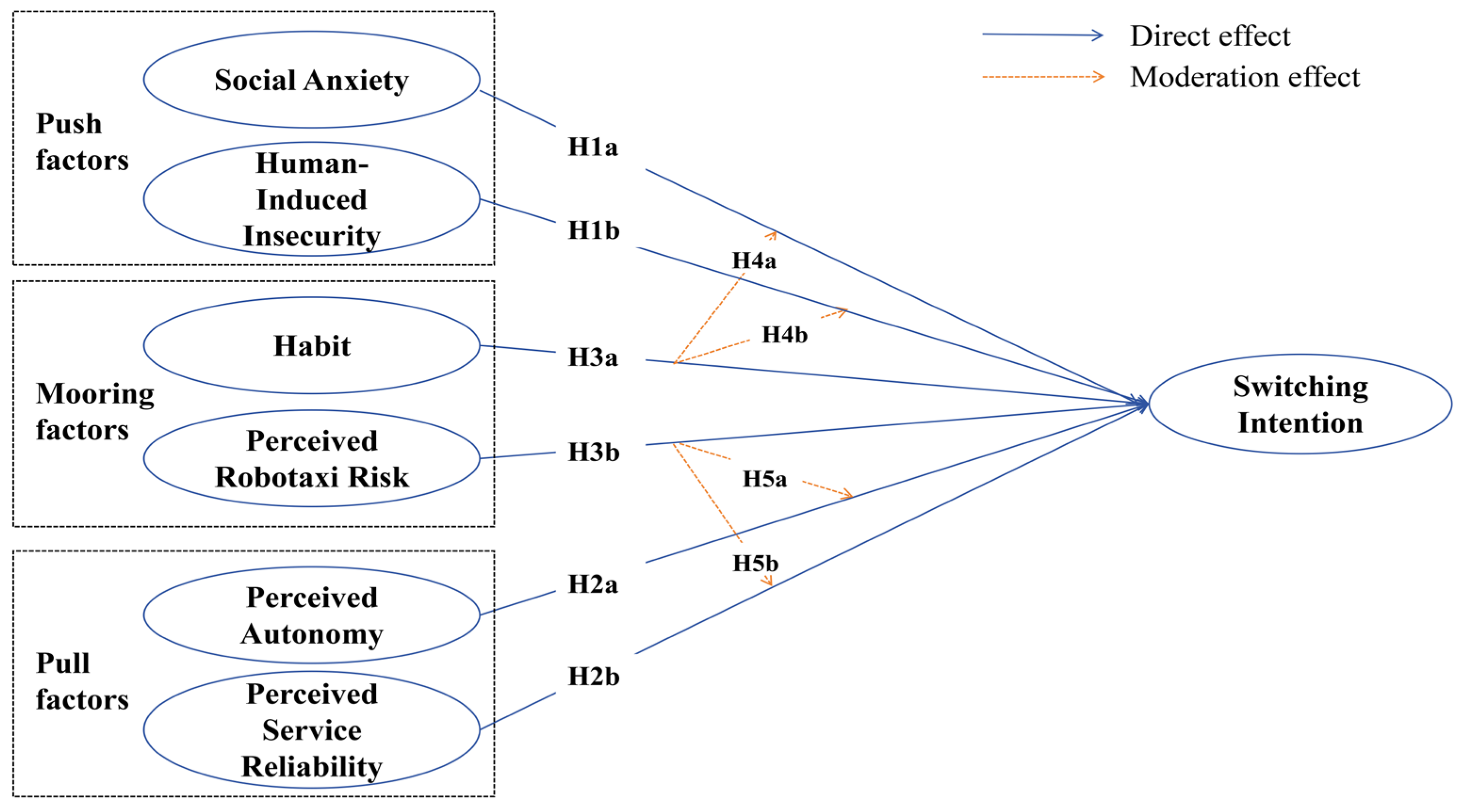
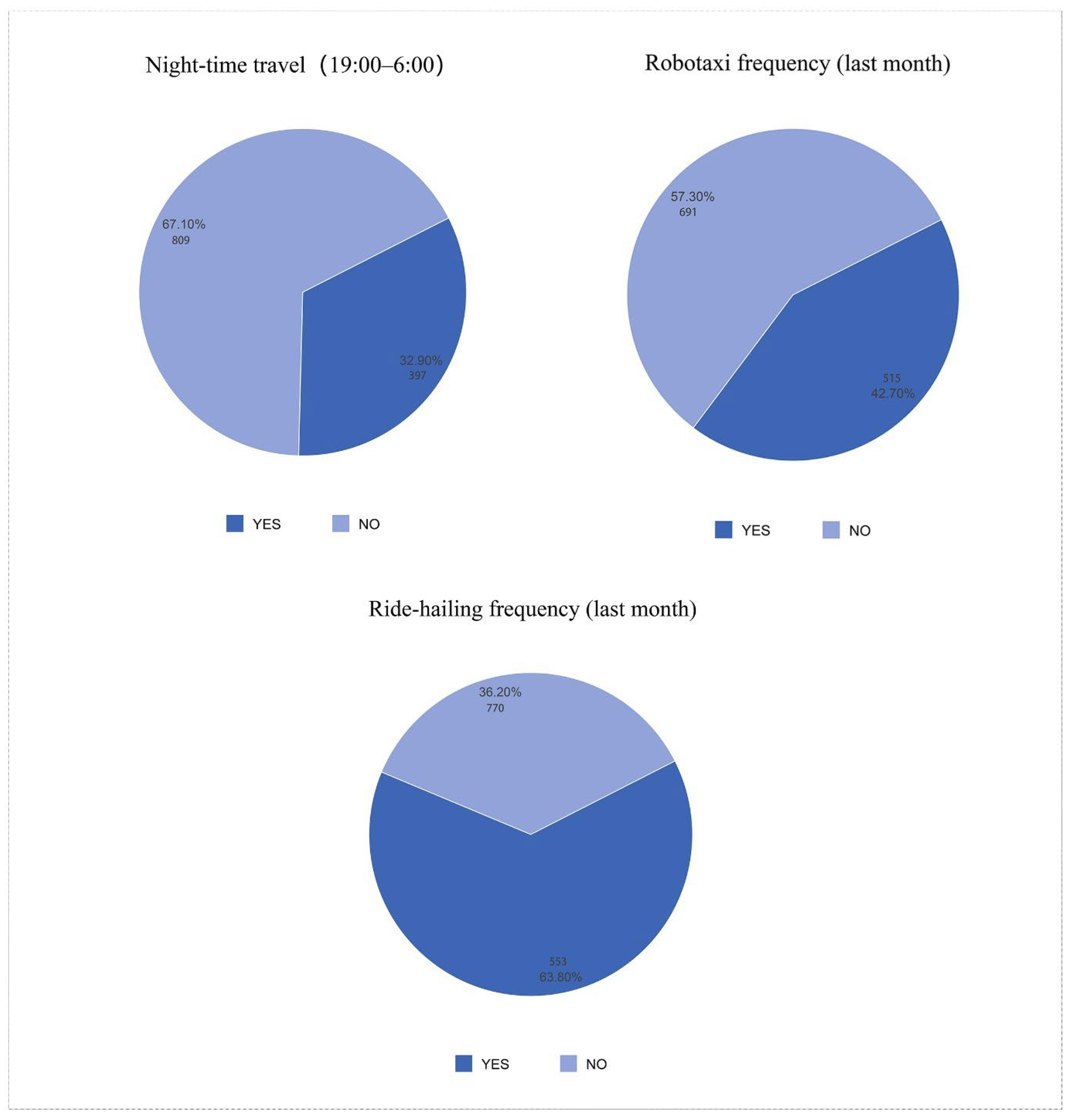
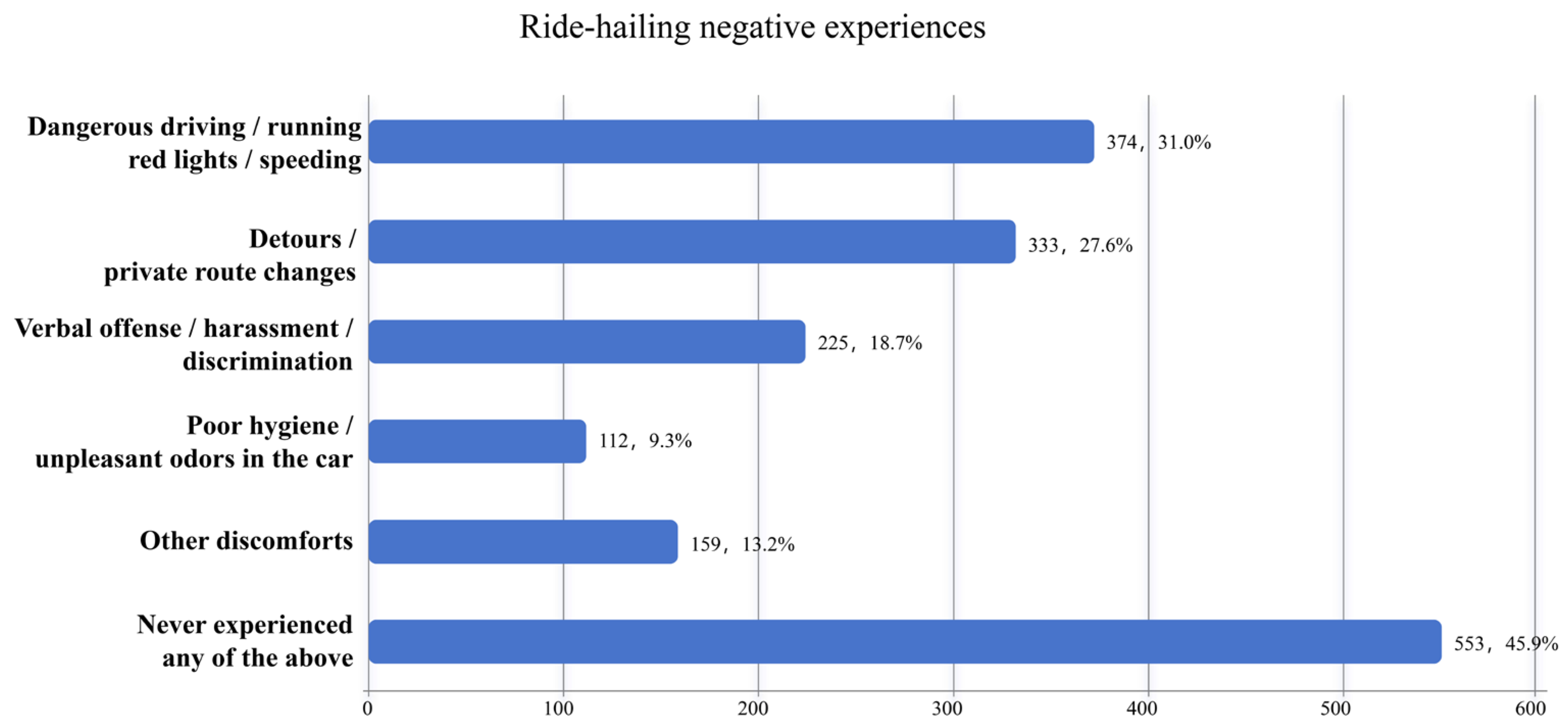

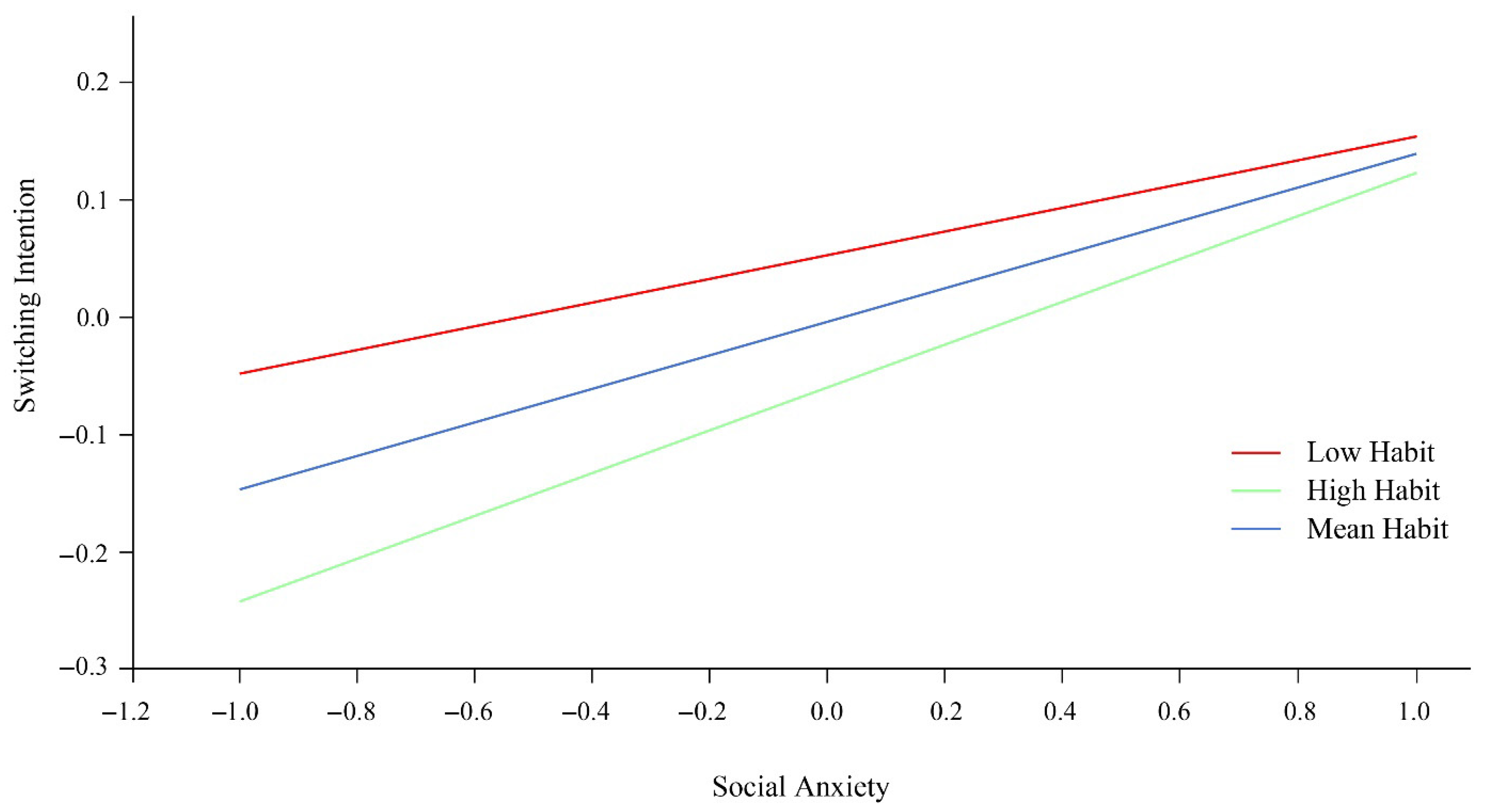
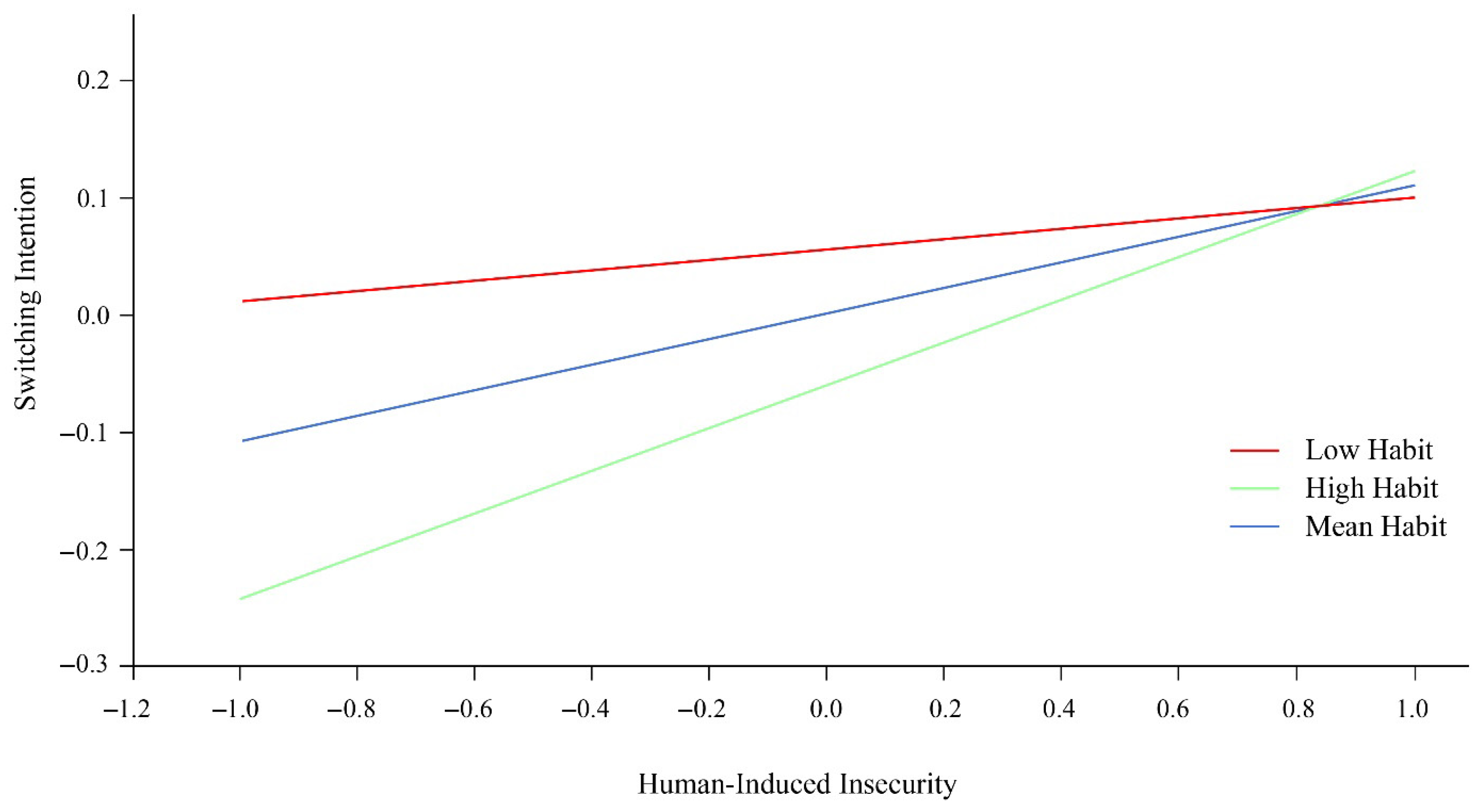

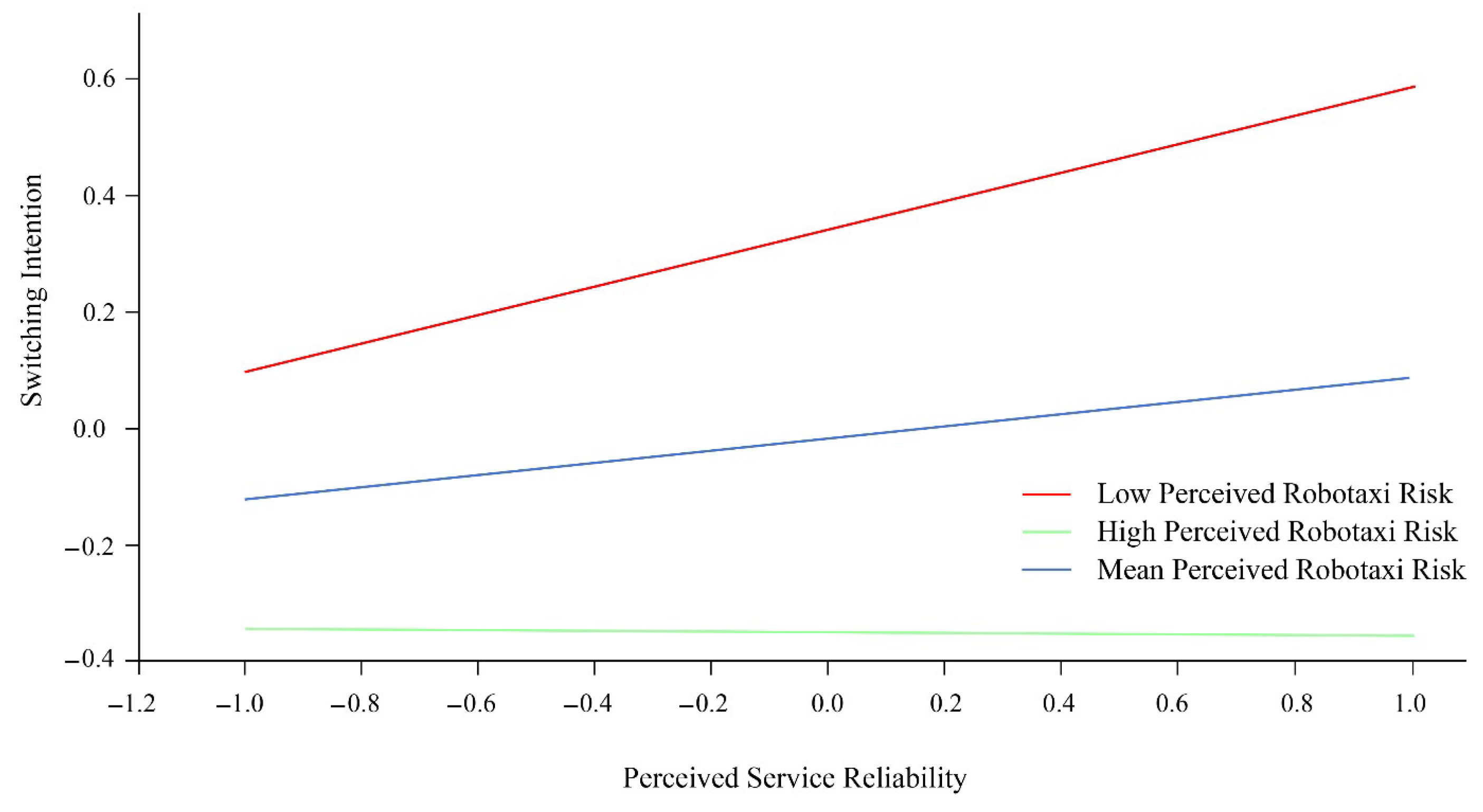

| Demographic Information | Category | Frequency | % |
|---|---|---|---|
| Gender | Male | 610 | 50.6 |
| Female | 596 | 49.4 | |
| Age | 18–24 | 366 | 30.1 |
| 25–34 | 484 | 40.1 | |
| 35–44 | 201 | 16.7 | |
| 45–54 | 118 | 9.8 | |
| ≥55 | 37 | 3.1 | |
| Education | <High School | 179 | 14.8 |
| High school or technical school | 286 | 23.7 | |
| Bachelor or Diploma | 608 | 50.4 | |
| ≥Master | 133 | 11.0 | |
| Monthly Income | <4000 ¥ (<≈ 556$) | 182 | 15.1 |
| 4001–8000 ¥ (≈556–1111$) | 511 | 42.4 | |
| 8001–12,000 ¥ (≈1112–1667$) | 377 | 31.3 | |
| ≥12,001 ¥ (≥≈1668 USD$) | 136 | 11.3 | |
| Driver’s license | Yes | 728 | 60.4 |
| No | 478 | 39.6 | |
| Vehicle ownership | Yes | 653 | 54.1 |
| No | 553 | 45.9 |
| Constructs | Codes | VIF (OM) | VIF (IM) | λ | α | CR | AVE |
|---|---|---|---|---|---|---|---|
| Social Anxiety | SAN1 | 1.828 | 1.324 | 0.833 | 0.838 | 0.892 | 0.673 |
| (SAN) | SAN2 | 1.891 | 0.829 | ||||
| SAN3 | 1.812 | 0.817 | |||||
| SAN4 | 1.741 | 0.802 | |||||
| Human-Induced | HII1 | 1.964 | 1.333 | 0.839 | 0.853 | 0.901 | 0.694 |
| Insecurity | HII2 | 2.037 | 0.851 | ||||
| (HII) | HII3 | 1.879 | 0.818 | ||||
| HII4 | 1.876 | 0.825 | |||||
| Perceived Autonomy | PAU1 | 1.897 | 1.521 | 0.825 | 0.854 | 0.901 | 0.695 |
| (PAU) | PAU2 | 1.937 | 0.841 | ||||
| PAU3 | 1.988 | 0.834 | |||||
| PAU4 | 1.926 | 0.835 | |||||
| Perceived | PSR1 | 1.888 | 1.267 | 0.826 | 0.845 | 0.896 | 0.682 |
| Service Reliability | PSR2 | 1.878 | 0.834 | ||||
| (PSR) | PSR3 | 1.831 | 0.812 | ||||
| PSR4 | 1.852 | 0.831 | |||||
| Habit | HAB1 | 1.848 | 1.186 | 0.823 | 0.845 | 0.896 | 0.683 |
| (HAB) | HAB2 | 1.894 | 0.824 | ||||
| HAB3 | 1.902 | 0.838 | |||||
| HAB4 | 1.829 | 0.819 | |||||
| Perceived | PRR1 | 2.084 | 1.464 | 0.853 | 0.854 | 0.901 | 0.695 |
| Robotaxi Risk | PRR2 | 1.986 | 0.841 | ||||
| (PRR) | PRR3 | 1.865 | 0.822 | ||||
| PRR4 | 1.854 | 0.819 | |||||
| Switching Intention | SWI1 | 1.697 | 0.847 | 0.790 | 0.877 | 0.705 | |
| (SWI) | SWI2 | 1.685 | 0.841 | ||||
| SWI3 | 1.614 | 0.830 |
| HAB | HII | PSR | SAN | PAU | PRR | SWI | |
|---|---|---|---|---|---|---|---|
| HAB | 0.826 | ||||||
| HII | −0.222 | 0.833 | |||||
| PSR | −0.258 | 0.293 | 0.826 | ||||
| SAN | −0.284 | 0.332 | 0.326 | 0.820 | |||
| PAU | −0.305 | 0.401 | 0.379 | 0.377 | 0.834 | ||
| PRR | 0.301 | −0.404 | −0.308 | −0.368 | −0.468 | 0.834 | |
| SWI | −0.290 | 0.414 | 0.365 | 0.412 | 0.433 | −0.541 | 0.839 |
| HAB | HII | PSR | SAN | PAU | PRR | SWI | |
|---|---|---|---|---|---|---|---|
| HAB | |||||||
| HII | 0.261 | ||||||
| PSR | 0.303 | 0.344 | |||||
| SAN | 0.336 | 0.393 | 0.386 | ||||
| PAU | 0.360 | 0.471 | 0.446 | 0.446 | |||
| PRR | 0.353 | 0.473 | 0.361 | 0.434 | 0.548 | ||
| SWI | 0.354 | 0.503 | 0.446 | 0.505 | 0.526 | 0.658 |
| Fit Indices | |
|---|---|
| SRMR | 0.039 |
| d_ULS | 0.569 |
| d_G | 0.232 |
| NFI | 0.889 |
| Q2 | R2 | Adjusted R2 | |
|---|---|---|---|
| SWI | 0.279 | 0.402 | 0.399 |
| Hypotheses | Paths | β | T | P | 0.025 | 0.975 | Results |
|---|---|---|---|---|---|---|---|
| H1a | SAN → SWI | 0.143 | 4.922 | 0.000 | 0.087 | 0.200 | √ |
| H1b | HII → SWI | 0.114 | 4.104 | 0.000 | 0.062 | 0.170 | √ |
| H2a | PAU → SWI | 0.112 | 3.387 | 0.001 | 0.048 | 0.178 | √ |
| H2b | PSR → SWI | 0.115 | 3.433 | 0.001 | 0.051 | 0.182 | √ |
| H3a | HAB → SWI | −0.060 | 2.435 | 0.015 | −0.110 | −0.014 | √ |
| H3b | PRR → SWI | −0.362 | 10.482 | 0.000 | −0.428 | −0.293 | √ |
| H4a | HAB × SAN → SWI | 0.039 | 1.249 | 0.212 | −0.023 | 0.101 | × |
| H4b | HAB × HII → SWI | 0.070 | 2.593 | 0.010 | 0.017 | 0.123 | × |
| H5a | PRR × PAU → SWI | −0.131 | 3.619 | 0.000 | −0.200 | −0.058 | √ |
| H5b | PRR ×PSR → SWI | −0.120 | 3.468 | 0.001 | −0.186 | −0.051 | √ |
| Group | Con. | Conf. Inv. | Comp. Inv. | PMI Est. | Equal Mean | Equal Var | FMI Est. | |||
|---|---|---|---|---|---|---|---|---|---|---|
| C = 1 | CI. | Diff. | CI. | Diff. | CI. | |||||
| Male | SAN | Yes | 0.998 | [0.999; 0.998] | Yes | −0.038 | [−0.110; 0.109] | −0.175 | [−0.167; 0.159] | NO |
| VS | HII | Yes | 1.000 | [0.999; 0.999] | Yes | −0.188 | [−0.108; 0.107] | 0.109 | [−0.112; 0.121] | NO |
| Female | PAU | Yes | 0.999 | [1.000; 0.999] | Yes | −0.158 | [−0.131; 0.121] | −0.077 | [−0.115; 0.123] | NO |
| PSR | Yes | 0.999 | [0.999; 0.998] | Yes | −0.197 | [−0.125; 0.122] | 0.028 | [−0.126; 0.134] | NO | |
| HAB | Yes | 0.999 | [0.999; 0.996] | Yes | 0.122 | [−0.111; 0.120] | −0.091 | [−0.123; 0.121] | NO | |
| PRR | Yes | 0.999 | [1.000; 0.999] | Yes | 0.264 | [−0.116; 0.118] | 0.161 | [−0.120; 0.110] | NO | |
| SWI | Yes | 1.000 | [1.000; 0.999] | Yes | −0.227 | [−0.114; 0.109] | 0.283 | [−0.154; 0.163] | NO | |
| Group | Relationship | β0 | β1 | Coefficient Difference |
|---|---|---|---|---|
| Male (0) | SAN → SWI | 0.056 | 0.248 *** | −0.192 ** |
| VS | HII → SWI | 0.085 * | 0.193 *** | −0.108 * |
| Female (1) | PAU → SWI | 0.103 * | 0.110 ** | −0.007 |
| PSR → SWI | 0.168 *** | 0.023 | 0.144 * | |
| HAB → SWI | −0.071 | −0.035 | −0.036 | |
| PRR → SWI | −0.261 *** | −0.418 *** | 0.157 * |
Disclaimer/Publisher’s Note: The statements, opinions and data contained in all publications are solely those of the individual author(s) and contributor(s) and not of MDPI and/or the editor(s). MDPI and/or the editor(s) disclaim responsibility for any injury to people or property resulting from any ideas, methods, instructions or products referred to in the content. |
© 2025 by the authors. Licensee MDPI, Basel, Switzerland. This article is an open access article distributed under the terms and conditions of the Creative Commons Attribution (CC BY) license (https://creativecommons.org/licenses/by/4.0/).
Share and Cite
Liu, Y.; Li, H.; Jiang, S.; Yim, J. Why Do Users Switch from Ride-Hailing to Robotaxi? Exploring Sustainable Mobility Decisions Through a Push–Pull–Mooring Perspective. Sustainability 2025, 17, 9987. https://doi.org/10.3390/su17229987
Liu Y, Li H, Jiang S, Yim J. Why Do Users Switch from Ride-Hailing to Robotaxi? Exploring Sustainable Mobility Decisions Through a Push–Pull–Mooring Perspective. Sustainability. 2025; 17(22):9987. https://doi.org/10.3390/su17229987
Chicago/Turabian StyleLiu, Yuanxiong, Hanxi Li, Shan Jiang, and Jinho Yim. 2025. "Why Do Users Switch from Ride-Hailing to Robotaxi? Exploring Sustainable Mobility Decisions Through a Push–Pull–Mooring Perspective" Sustainability 17, no. 22: 9987. https://doi.org/10.3390/su17229987
APA StyleLiu, Y., Li, H., Jiang, S., & Yim, J. (2025). Why Do Users Switch from Ride-Hailing to Robotaxi? Exploring Sustainable Mobility Decisions Through a Push–Pull–Mooring Perspective. Sustainability, 17(22), 9987. https://doi.org/10.3390/su17229987







